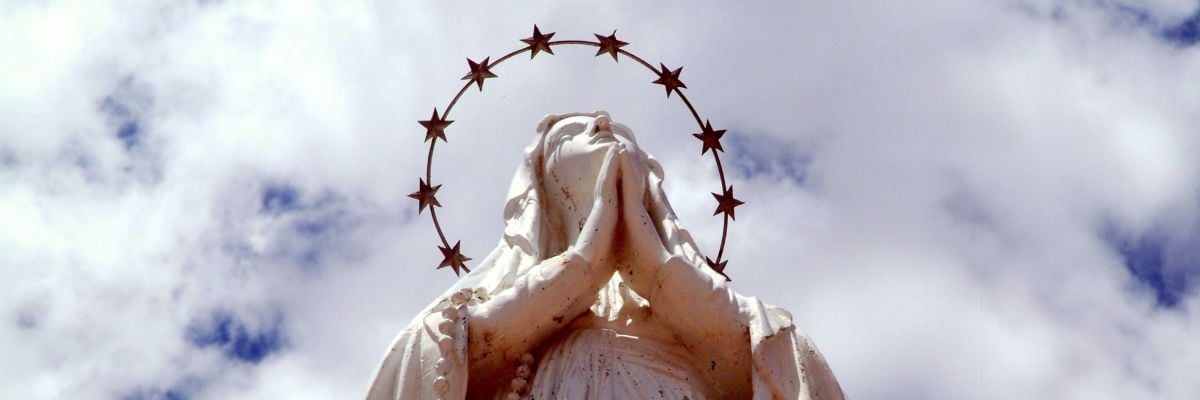
Usually, Catholic apologetical outreach to Protestants occurs using appeals to reason, typically closely tied to debates over the meaning of Holy Scripture or who has legitimate religious authority. Thus, we Catholics talk about the biblical evidence for the seven sacraments, Petrine primacy, and the Catholic understanding of salvation. We talk about the need for an authority to determine the contents and meaning of the Bible, or to adjudicate various theological disputes.
There’s nothing wrong with any of that. But Catholics can also engage Protestants on matters related less to reason and more to faith—or, in Protestants’ case, their lack of it.
Don’t misunderstand me—I’m not arguing that Protestants have no faith, or even necessarily less faith than any individual Catholic. Indeed, I’d wager many of my Protestant brethren often demonstrate more faith than I do, at least in the sense of trusting in God’s power in their lives. Rather, what I mean by faith is a continued recognition and acceptance of God’s miraculous workings throughout salvation history as a motive of credibility for the authority of his Church.
The Catechism of the Catholic Church explains the motives of credibility as follows:
What moves us to believe is not the fact that revealed truths appear as true and intelligible in the light of our natural reason: we believe “because of the authority of God himself who reveals them, who can neither deceive nor be deceived.” So “that the submission of our faith might nevertheless be in accordance with reason, God willed that external proofs of his Revelation should be joined to the internal helps of the Holy Spirit.” Thus the miracles of Christ and the saints, prophecies, the Church’s growth and holiness, and her fruitfulness and stability “are the most certain signs of divine Revelation, adapted to the intelligence of all”; they are “motives of credibility” (motiva credibilitatis), which show that the assent of faith is “by no means a blind impulse of the mind” (156).
In short, the motives of credibility are reasonable, investigable proofs that God (and his Church) are precisely who they claim to be, and thus the act of faith in Christ (and his Church) need not be an unreasonable or emotional decision.
In this article, I’d like to focus on the miracles associated with the Church—but not those associated with Christ. Rather, I want to argue that the miracles attributed to the most famous Marian apparitions present a powerful motive of credibility that few Protestants have considered, and fewer still have offered anything resembling a coherent argument to disprove them.
Take the 1531 Marian apparition at Tepeyac, Mexico, also known as Our Lady of Guadalupe. According to historical accounts, Mary the mother of Jesus several times visited the Aztec peasant Juan Diego and requested that a church be built at the site of her appearance, in what is now Mexico City. After some resistance, Juan Diego agreed to bring her request to the local bishop, Juan de Zumárraga. The bishop in turn requested a sign, which Mary provided in the form of miraculously healing Juan Diego’s uncle, Juan Bernardino, and gathering flowers from the summit of Tepeyac Hill, in the middle of December.
Juan Diego dutifully collected the flowers in his cloak, or tilma, which he then presented to the bishop. The image of Mary, depicted as an Aztec princess, remains embedded to this day on the tilma, which can still be seen today in a basilica in Mexico City. It remains—almost five hundred years removed from its creation, in a climate that should have ravaged the fabric, and in spite of an attempt by an anti-Catholic secularist to destroy it with a bomb in 1921.
Or consider Lourdes, where Mary appeared to the French peasant girl Bernadette Soubirous eighteen times in 1858. Mary instructed Bernadette to dig in an obscure grotto, which uncovered a spring which to date has healed at least seventy people. Despite early resistance from local Church officials, Bernadette persevered in visiting the site, and soon curious pilgrims began to arrive. The peasant girl had no desire to become a spectacle, and soon thereafter retreated into relative obscurity, joining a religious order, the Sisters of Charity. The miracles continued.
Finally, there is Fatima, where Mary appeared to three Portuguese peasant children in 1916 and 1917, encouraging them to pray the rosary and engage in eucharistic devotion. Yet again, relatives and neighbors were incredulous. But in time, thousands of pilgrims who learned of miracles flocked to Fatima. In response, a provincial official had the children—Lúcia dos Santos and her cousins Francisco and Jacinta Marto—imprisoned and interrogated. The children refused to recant their story. Then, on October 29, following a promise by the Marian apparition of a miracle, the sun appeared to dance and emitted radiant colors before a crowd of at least 30,000 people, in what has become called the “Miracle of the Sun.”
What unites these three stories, among other things, is eyewitness testimony, conversion of hearts, and miracles confirming someone’s religious authority, in this case that of Mary and the Church. This, if you think about it, sounds quite a bit like the miracles performed by Christ and his apostles in the New Testament. Indeed, in John 10:37-38, we read Christ saying,
If I am not doing the works of my Father, then do not believe me; but if I do them, even though you do not believe me, believe the works, that you may know and understand that the Father is in me and I am in the Father.
In other words, even if you don’t believe Jesus because of his teaching, you should believe because of the miracles he performed. In a sense, that’s what we, almost two thousand years removed from Christ’s earthly ministry, do: we believe, because of eyewitness testimony, that Christ did indeed do miraculous things, including, most incredibly, rising from the dead.
That, in turn, provokes a question: if Jesus himself says we should believe in him because of his miracles, shouldn’t we believe in those claiming to represent Christ if their words are attended by miracles? Juan Diego, Bernadette Soubirous, and the Fatima children all claimed they saw Mary. Their claims were confirmed by miracles of which there is abundant evidence, a veritable motive of credibility. So, it’s fair to ask, why don’t Protestants believe in them?



